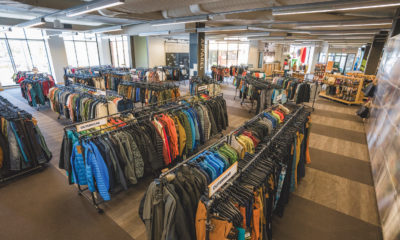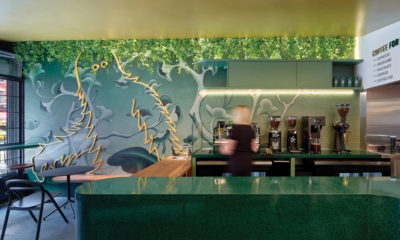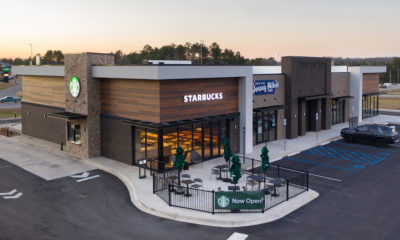For two weeks in May, designers descend on the streets of New York for NYCxDesign, an annual event that “celebrates a world of design and showcases over a dozen design disciplines through events taking place across the city’s five boroughs.” From the International Contemporary Furniture Fair (ICFF), now in its 30th year, which brings the latest furniture, finishes, and lighting to the Javits Center, to WantedDesign, which sets up in both Manhattan and Brooklyn, there is never a shortage of inspiration for any designer. Many of the events provide evocative presentations and engaging conversations alongside their cutting-edge installations.
Sight Unseen OFFSITE, hosted by Sight Unseen magazine, brought together collaborations with renowned retailers and emerging independent design studios, creating powerful pairings that push creative boundaries to be forward-thinking. Levi’s Made & Crafted showcased a collection inspired by the colors, textures and patterns of the desert: furniture by Syrette Lew of Moving Mountains, ceramic lamps by Giselle Hicks and a rug collection by Cold Picnic. Fashion designer Narciso Rodriguez teamed up with interior designer Kelly Behun to create a mixed media chair that forces the user to sit in unusual ways and also references the pale desert color palette. Opening Ceremony x Crosby Studio captured the ultra violet craze with a furniture and rug collection of unique forms. Creatures of Comfort debuted a collection from Studio Say/So, a collection from product designer Sophie Borch-Jacobsen and interior designer Sarita Posada. Not only was their collection beautiful, designed to reference the vibrant colors of Colombia and materials from 1930s French and 1970s Italian designs; I had a proud educator moment as Sarita was a former student in my interior finish materials course at the University of Oregon.

Photography: Rebekah L. Matheny, Columbus, Ohio
With only a short amount of time in the city, I tried to cover as much ground as possible, soaking up all the most evocative ideas. What rose to the top, for me, was the focus on sustainability. Major brands like Muji, Glossier and Eileen Fisher seized the opportunity to educate viewers on the raw materials and lifecycle impact of consumer culture.
Material Garden
Muji’s Material Garden, designed by Ladies & Gentlemen Studio, took people on a Zen journey through the process of making their products. Each vignette showed the product collection within the context of its raw material, demonstrating that the products we purchase can come from nature. Building from Muji’s Japanese roots, the exhibit aimed to evoke curiosity through the haptic experience (and sensorial experience with the inclusion of essential oil diffusion), while demonstrating their honest approach to materiality.


Photography: Rebekah L. Matheny, Columbus, Ohio
Transparent Beauty
Also featured at Sight Unseen OFFSITE was a collaboration by beauty brand Glossier. They teamed up with Kim Markel to transform empty product containers, along with other reclaimed plastics, into eye-catching translucent furniture. Just one chair uses 50 of the brand’s iconic pastel pink jars. What if a brand recycled their product waste into merchandising displays that could then be recycled into updated fixtures time and again? Imagine the reduced impact that the industry could have if every merchandising display was made of recycled material!

Photography: Rebekah L. Matheny, Columbus, Ohio
Waste No More
Originally debuted during Salone del Mobile in Millan, Eileen Fisher’s “Waste No More” exhibit was a call-to-action for the fashion apparel industry, as well as consumers, to rethink their behaviors. As Fisher stated before, “Textiles and apparel have a huge environmental impact — and our industry’s current model is unsustainable. We’re using up natural resources faster than they can be renewed. We’re making more and more stuff. And after each season, we toss out the old and move onto what’s next. Where does this mountain of used and unsold clothes go? Roughly 85 percent becomes waste in a landfill –including many of the items donated to charity.”
We recently saw the headlines that H&M was battling with a similar dilemma. As designers, what can we do to mitigate this issue? Brining her message to New York, WantedDesign Manhattan showcased Eileen Fisher’s collaborative initiative with DesignWork to create felted and stitched wall hangings, upholstery, acoustical panels and interior accessories for hospitality and other public spaces. Madewell recently launched a recycling program that turns old jeans into insulation for homes in communities in need. Could this be one solution, where we down-cycle product waste into interior finishes to be used within their own store’s design or the construction of homes, schools and community spaces in underprivileged communities?

Photography: Rebekah L. Matheny, Columbus, Ohio
Zero Waste Bistro
In conjunction with the Finnish Cultural Institute in New York and WantedDesign Manhattan, the Zero Waste Bistro was co-curated by Harri Koskinen and designer Linda Bergroth. Referencing the “zero-waste food philosophy” from Helsinki-based restaurant Nolla into the space’s design, the entire activation was asking diners and observers the question: “What if all plastic was reused and recycled? What if all packaging was made of plastic-free materials? What if we only bought products we love and last a lifetime? What if all restaurants committed to a circular economy, refusing, reducing, and reusing waste?”
By stepping into what they refer to as a laboratory, you experienced firsthand what a sustainable world could be like. From the countertops to the walls, every surface material is made from recycled materials and is recyclable. The furniture and light fixtures are classic Finnish designs that are made to last. Even the cutlery and tableware supports the zero-waste aesthetic.


Photography: Rebekah L. Matheny, Columbus, Ohio
June 1, Bon Appetite foodservice (a subsidiary of Compass Group USA, the largest foodservice management company in the U.S.) announced they will be leading a plastic revolution by banning straws and stirrers, which follows in the footsteps of many European countries banning single-use plastic products within restaurants and retail. Even McDonalds will be following suit by testing paper straws later this year. Maybe this eco-revolution isn’t so far off, after all, so how can we begin to think about our restaurant and retail designs in this new manner? What could this eco-revolution look like?
Having toured the NYCxDesign events all day Friday and Saturday, I spent Sunday at ICFF with my friend Royce Epstein, a powerhouse in the world of interior finish material design and trend forecasting. She too is passionate about reducing the impact our industry has on the planet, and we both couldn’t help but see how sustainability was showcased around every other turn in the massive exhibit in the Javits Center. This certainly made our eco-hearts happy. Some standouts included numerous moss wall systems that would allow brands to create colored logos and patterns or art insulations, while simultaneously cleaning the air.

Photography: Rebekah L. Matheny, Columbus, Ohio
As a leader in recycled furniture, first with recycled aluminum in 1944 and then with recycled PET in the 111 Navy, and now with the introduction of reclaimed wood polypropylene, the 1-in. reclaimed makes the discarded distinctive. In an exhibit by the Virginia Tech School of Architecture, which explored recycled material processes, one student investigated up-cycled skateboard and HDPE as furniture parts and another shopping bags as materials. With all of these new material uses, the future of our environments will begin to have a new vernacular.

Photography: Rebekah L. Matheny, Columbus, Ohio
Scrap Culture
As a visionary and veteran materials and product specialist, Royce Epstein’s passion for cultural trends and the meaning of materials in a broad context provided insight into this new sustainable material vernacular. Her talk during ICFF, “Scrap Culture: Sustainable Design Practices in a World of Waste,” illustrated how designers from all disciplines are trying to address the issue of waste through the exploration of new materials and production processes, creating a new design language and landscape that moves beyond industry or craft. Her presentation asked us to consider how we can bridge design and sustainability for interiors, architecture, product design, fashion and the arts as we head towards creating a more sustainable future.

Photography: Rebekah L. Matheny, Columbus, Ohio; Slide imagery courtesy of Royce Epstein, Philadelphia
Royce left me with a significant question to contemplate: We as temporary visitors to this planet need to confront our relationship with nature. What are we leaving behind?”
As designers and retailers, we should be asking ourselves: what are we leaving behind? What mark will we leave on the planet? And how can our work today positively impact the future?
Rebekah L. Matheny is the Assistant Professor of Interior Design at The Ohio State University (Columbus, Ohio), where she teaches courses in interior finish materials, lighting design and design studios that integrate a retail brand strategy process. Matheny’s research investigates the sensory perception of interior finish materials and their application in retail design to create an emotional connection between the customer and the brand. Through her research and teaching she strives to pave a path to a more environmentally and socially sustainable retail culture.


 Photo Gallery3 days ago
Photo Gallery3 days ago
 Headlines2 weeks ago
Headlines2 weeks ago
 Sector Spotlight2 weeks ago
Sector Spotlight2 weeks ago
 Headlines5 days ago
Headlines5 days ago
 Headlines3 days ago
Headlines3 days ago
 Headlines1 week ago
Headlines1 week ago
 Designer Dozen1 week ago
Designer Dozen1 week ago
 Headlines2 weeks ago
Headlines2 weeks ago


































